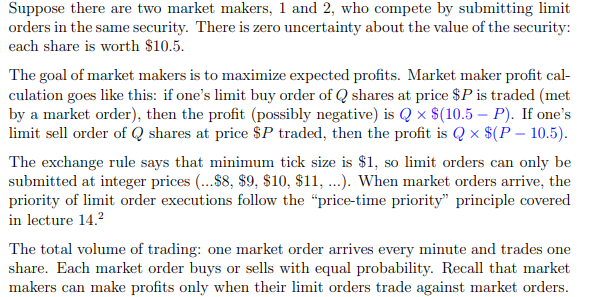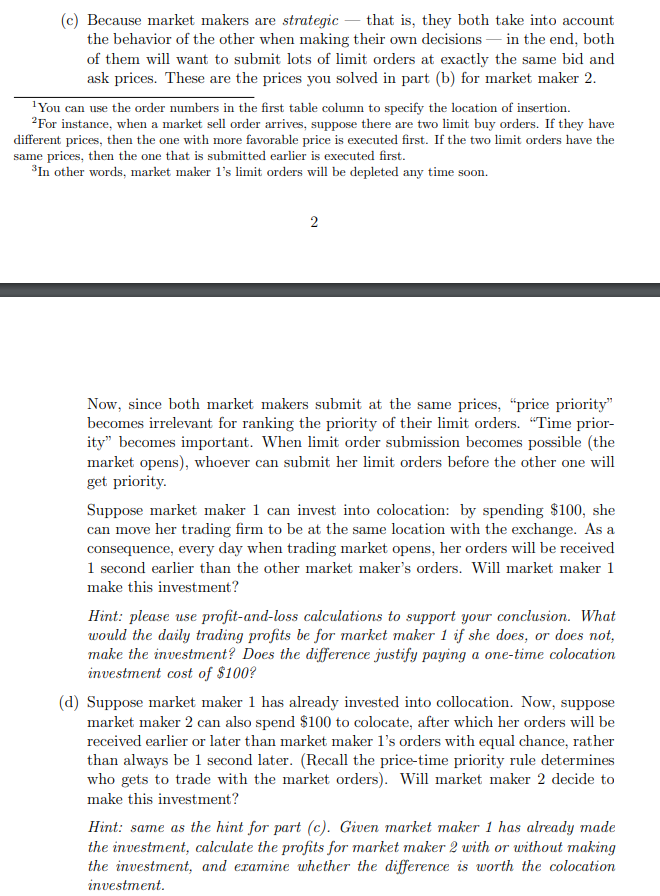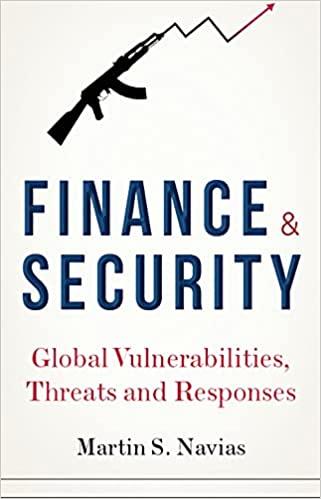

Suppose there are two market makers, 1 and 2, who compete by submitting limit orders in the same security. There is zero uncertainty about the value of the security: each share is worth $10.5. The goal of market makers is to maximize expected profits. Market maker profit cal- culation goes like this: if one's limit buy order of Q shares at price $P is traded (met by a market order), then the profit (possibly negative) is Q x $(10.5 P). If one's limit sell order of shares at price $P traded, then the profit is Q $(P 10.5). The exchange rule says that minimum tick size is $1, so limit orders can only be submitted at integer prices (...$8, $9, $10, $11, ...). When market orders arrive, the priority of limit order executions follow the "price-time priority" principle covered in lecture 14.2 The total volume of trading: one market order arrives every minute and trades one share. Each market order buys or sells with equal probability. Recall that market makers can make profits only when their limit orders trade against market orders. (c) Because market makers are strategic that is, they both take into account the behavior of the other when making their own decisions in the end, both of them will want to submit lots of limit orders at exactly the same bid and ask prices. These are the prices you solved in part (b) for market maker 2. You can use the order numbers in the first table column to specify the location of insertion. 2 For instance, when a market sell order arrives, suppose there are two limit buy orders. If they have different prices, then the one with more favorable price is executed first. If the two limit orders have the same prices, then the one that is submitted earlier is executed first. *In other words, market maker 1's limit orders will be depleted any time soon. 2 Now, since both market makers submit at the same prices, "price priority" becomes irrelevant for ranking the priority of their limit orders. "Time prior- ity becomes important. When limit order submission becomes possible (the market opens), whoever can submit her limit orders before the other one will get priority. Suppose market maker 1 can invest into colocation: by spending $100, she can move her trading firm to be at the same location with the exchange. As a consequence, every day when trading market opens, her orders will be received 1 second earlier than the other market maker's orders. Will market maker 1 make this investment? Hint: please use profit-and-loss calculations to support your conclusion. What would the daily trading profits be for market maker 1 if she does, or does not, make the investment? Does the difference justify paying a one-time colocation investment cost of $100? (a) Suppose market maker 1 has already invested into collocation. Now, suppose market maker 2 can also spend $100 to colocate, after which her orders will be received earlier or later than market maker l's orders with equal chance, rather than always be 1 second later. (Recall the price-time priority rule determines who gets to trade with the market orders). Will market maker 2 decide to make this investment? Hint: same as the hint for part (c). Given market maker 1 has already made the investment, calculate the profits for market maker 2 with or without making the investment, and examine whether the difference is worth the colocation investment. Suppose there are two market makers, 1 and 2, who compete by submitting limit orders in the same security. There is zero uncertainty about the value of the security: each share is worth $10.5. The goal of market makers is to maximize expected profits. Market maker profit cal- culation goes like this: if one's limit buy order of Q shares at price $P is traded (met by a market order), then the profit (possibly negative) is Q x $(10.5 P). If one's limit sell order of shares at price $P traded, then the profit is Q $(P 10.5). The exchange rule says that minimum tick size is $1, so limit orders can only be submitted at integer prices (...$8, $9, $10, $11, ...). When market orders arrive, the priority of limit order executions follow the "price-time priority" principle covered in lecture 14.2 The total volume of trading: one market order arrives every minute and trades one share. Each market order buys or sells with equal probability. Recall that market makers can make profits only when their limit orders trade against market orders. (c) Because market makers are strategic that is, they both take into account the behavior of the other when making their own decisions in the end, both of them will want to submit lots of limit orders at exactly the same bid and ask prices. These are the prices you solved in part (b) for market maker 2. You can use the order numbers in the first table column to specify the location of insertion. 2 For instance, when a market sell order arrives, suppose there are two limit buy orders. If they have different prices, then the one with more favorable price is executed first. If the two limit orders have the same prices, then the one that is submitted earlier is executed first. *In other words, market maker 1's limit orders will be depleted any time soon. 2 Now, since both market makers submit at the same prices, "price priority" becomes irrelevant for ranking the priority of their limit orders. "Time prior- ity becomes important. When limit order submission becomes possible (the market opens), whoever can submit her limit orders before the other one will get priority. Suppose market maker 1 can invest into colocation: by spending $100, she can move her trading firm to be at the same location with the exchange. As a consequence, every day when trading market opens, her orders will be received 1 second earlier than the other market maker's orders. Will market maker 1 make this investment? Hint: please use profit-and-loss calculations to support your conclusion. What would the daily trading profits be for market maker 1 if she does, or does not, make the investment? Does the difference justify paying a one-time colocation investment cost of $100? (a) Suppose market maker 1 has already invested into collocation. Now, suppose market maker 2 can also spend $100 to colocate, after which her orders will be received earlier or later than market maker l's orders with equal chance, rather than always be 1 second later. (Recall the price-time priority rule determines who gets to trade with the market orders). Will market maker 2 decide to make this investment? Hint: same as the hint for part (c). Given market maker 1 has already made the investment, calculate the profits for market maker 2 with or without making the investment, and examine whether the difference is worth the colocation investment








